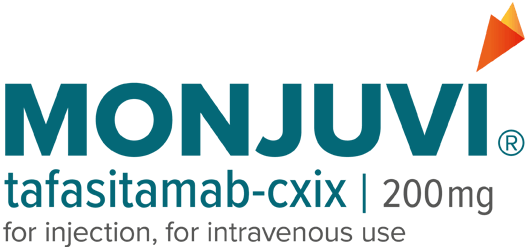For healthcare professionals
For patients and caregivers
Facilitating coverage and coding
This information is intended to provide an overview of MONJUVI coding and coverage information. It does not guarantee payment or coverage for any product or service.
MONJUVI has a unique J-Code
J9349: Injection, tafasitamab-cxix, 2 mg
Payer requirements regarding detailed claim form information may vary. It is important to check with individual payers on their specific requirements, especially as related to units of measurement.
MONJUVI J-Code billing unit conversion
J9349 Billing Unit
2 mg
1 Single-Dose Vial of MONJUVI
200 mg
200 mg Vial
100 units
The total number of mg administered will vary based on patient weight.
What can I do to support timely reimbursement of MONJUVI claims?
Follow the payer’s policy information regarding MONJUVI coverage requirements:
- Prior authorization
- Patient medical history and prior treatments
- Other supporting clinical information
When completing the 1450 or 1500 Claims Form, use the MONJUVI specific J-Code: J9349 (Injection, tafasitamab-cxix, 2 mg).
Include correct number of units administered
- For example, one 200 mg vial is equal to 100 units
- Separately, use the JW modifier to report discarded units as required
Ensure accuracy of the following information needed to process the claim:
- CPT code
- Patient diagnosis and information
- Correct NDC format (Payers typically require the 11-digit format.)
- Prior authorization number (if applicable)
Check your payer agreements to ensure you understand any specific reimbursement needs for MONJUVI
Make sure electronic claims are successfully submitted.
The information herein is provided for educational purposes only. Insurance coverage and reimbursement are not guaranteed. Coverage and reimbursement may vary significantly by payer, plan, patient, and setting of care. It is the sole responsibility of the healthcare provider to select the proper codes and ensure the accuracy of all statements used in seeking coverage and reimbursement for an individual patient.
For billing and coding or reimbursement questions, or to request support from a member of the field access and reimbursement team, call (855) 421-6172, (855) 421-6 172, Monday to Friday 8 am to 8 pm ET.
For information on MONJUVI coding and billing requirements, provider readiness and sample forms, please download the MONJUVI Billing & Coding Guide.
Creating your patient’s treatment calendar
Step 1 Once you and your patient have agreed upon a date to begin treatment with MONJUVI, select that date in the calendar below.
When the start date has been selected, the calendar will automatically fill in the remaining dates of your patient’s treatment regimen.
Step 2 Click the “Create Calendar” button to get a copy of your patient’s treatment calendar.
This calendar is intended for use as a resource for you and your patients. Information provided in this tool, including any output from its interactive features, should not be considered an alternative to your medical advice.










